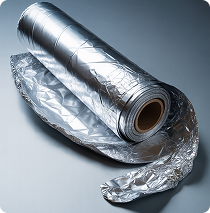How to Replace
Aluminum Foil
Discover reusable alternatives that clean better and never leave you scrambling to the store.

The Problem With Aluminum Foil
⚡The Energy Monster
- 15 MWh of electricity per ton: Producing aluminum foil uses staggering amounts of energy—enough to power the average home for 5 years—just for a single-use product.
- Energy costs doubled foil prices: Shoppers have noticed foil boxes jumping from $15 to $30 since 2020—driven by steep increases in electricity and raw material costs.
- 83% more energy than plastic wrap: Foil takes far more energy to produce than plastic wrap—making it one of the least efficient options for disposable food storage.
⚠️The Heat-Activated Health Hazard
- Up to 378% aluminum increase in food: Research shows aluminum can leach into food while cooking, raising content levels by several hundred percent in some cases.
- Acidic foods + heat = maximum leaching: Tomatoes, citrus, and vinegar-based marinades can increase aluminum migration from foil—especially when heated.
- Linked to Alzheimer’s and bone disorders: Studies suggest long-term exposure to aluminum may be connected to brain and bone issues. While debate continues, limiting exposure is often recommended.
🏭Mining Devastation & Toxic Legacy
- Rainforests cleared for bauxite ore: Vast rainforest areas in countries like Brazil and Australia are cleared to extract bauxite—the raw material used to make aluminum.
- 2.5 tons of caustic “red mud” per ton: Aluminum production generates huge amounts of red mud—a toxic, caustic byproduct that’s difficult and dangerous to store.
- 500% higher environmental impact than recycled: Virgin aluminum production uses around 20 times more energy than recycling—but most foil isn’t recycled at all.
♻️The Recycling Myth
- Only 35% recycling rate vs 63% for cans: Because food often contaminates foil, most of it ends up in landfills—even though aluminum is technically recyclable.
- 200–500 years to decompose: Unlike paper or organic waste, foil can stick around in landfills for centuries—adding to long-term pollution problems.
- Must be tennis-ball sized and spotless: Most recycling programs require foil to be perfectly clean and balled up to the size of a tennis ball—otherwise it’s rejected.
This content is for informational purposes only and is not professional advice. Always do your own research before making decisions. No guarantees are made regarding accuracy or outcomes.
Top Picks